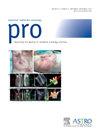数字化工具能否改善头颈部癌症患者对治疗方案的理解,并提高医疗服务提供者与患者沟通的自我认知能力?缩写标题:了解头颈癌治疗的数字化工具。
IF 3.4
3区 医学
Q2 ONCOLOGY
引用次数: 0
摘要
目的:MyCareGorithm 公司最近开发了一种数字可视化交流工具,其中包含对癌症患者治疗和手术的解释。本研究将评估这一新型工具能否提高患者和医疗服务提供者的满意度:在一项经 IRB 批准的前瞻性试点研究中,接受头颈部癌症放射治疗的患者和护理人员在一家医疗机构接受了使用该数字工具的初步咨询,并完成了一项包含 6 个问题的调查,以评估他们对自身疾病的了解程度。医疗服务提供者完成了一项包含 7 个问题的调查,以评估他们的满意度。回答 4 个或更多 "是 "的患者和护理人员以及回答 5 个或更多 "是 "的医疗服务提供者被定义为 "满意"。为了获得 90% 的力量来检测 "满意 "患者的比例(假设为 75%)是否大于 50%,且使用单侧 Z 检验的显著性水平为 5%,我们计划招募 30 名患者:30 名患者参与并完成了所有调查。大多数患者为男性(66%)、白人(60%),英语为主要语言(93%)。患者最常见的病症是口咽癌(23%)。总体而言,30 位患者中有 27 位(90%;单侧 95%CI:76.1%)对数字工具表示满意(z = 4.38,p < 0.05),17 位护理人员中有 16 位(94%;单侧 95%CI:74.8%)对数字工具表示满意,100% 的医疗服务提供者对数字工具表示满意。大多数患者(90%)和护理人员(94%)认为该工具提高了他们对疾病的理解。一名男性患者对所有 6 个问题的回答都是 "否",并表示该工具只提供了些许帮助。一名女性对所有问题的回答也是 "否",她认为如果没有提供者的解释,该工具本身对她没有帮助。在 30 名患者中,有 26 人(87%)留在本院接受治疗:这些研究结果表明,使用数字可视化工具后,患者、护理人员和医疗服务提供者对初次咨询的满意度很高。应大力考虑在临床实践中常规使用该工具。本文章由计算机程序翻译,如有差异,请以英文原文为准。
Can a Digital Tool Improve the Understanding of Treatment Option for Patients With Head/Neck Cancer and Increase Providers’ Self-perceived Ability to Communicate With Patients?
A digital visual communication tool was recently developed by MyCareGorithm that incorporates explanations of treatments and procedures for cancer patients. This study evaluated if this novel tool can enhance both patient and provider satisfaction. In an IRB approved, prospective, pilot study, patients and caregivers at a single institution receiving head and neck cancer radiation underwent an initial consult using this digital tool and completed a survey of 6 questions to evaluate their understanding of their disease. Providers completed a 7-question survey to rate their satisfaction. Patients and caregivers with 4 or more “Yes” answers and providers with 5 or more “Yes” answers were defined as “Satisfied.” To obtain 90% power to detect that the proportion of “Satisfied” patients (assumed 75%) is greater than 50% with a significance level 5% using a 1-sided Z test, we planned to enroll 30 patients. Thirty patients enrolled and completed all surveys. Most patients were male (66%), White (60%), and spoke English as a primary language (93%). Patients most commonly had oropharyngeal cancer (23%). Overall, 27 of the 30 patients (90%; 1-sided 95% CI, 76.1%) were satisfied (z = 4.38, P < .05), 16 of the 17 caregivers (94%; 1-sided 95% CI, 74.8%) were satisfied, and 100% of providers were satisfied with the digital tool. Most patients (90%) and caregivers (94%) felt that the tool improved their understanding of the disease. One man answered “No” for all 6 questions, commenting that it was only marginally helpful. One woman also answered “No” for all questions, commenting that she did not find it helpful on its own without the provider's explanation. Of the 30 patients, 26 (87%) stayed at our institution to receive treatment. These findings showed high rates of patient, caregiver, and provider satisfaction with their initial consult when incorporating a digital visual tool. Its routine use in clinical practice should be strongly considered.
求助全文
通过发布文献求助,成功后即可免费获取论文全文。
去求助
来源期刊

Practical Radiation Oncology
Medicine-Radiology, Nuclear Medicine and Imaging
CiteScore
5.20
自引率
6.10%
发文量
177
审稿时长
34 days
期刊介绍:
The overarching mission of Practical Radiation Oncology is to improve the quality of radiation oncology practice. PRO''s purpose is to document the state of current practice, providing background for those in training and continuing education for practitioners, through discussion and illustration of new techniques, evaluation of current practices, and publication of case reports. PRO strives to provide its readers content that emphasizes knowledge "with a purpose." The content of PRO includes:
Original articles focusing on patient safety, quality measurement, or quality improvement initiatives
Original articles focusing on imaging, contouring, target delineation, simulation, treatment planning, immobilization, organ motion, and other practical issues
ASTRO guidelines, position papers, and consensus statements
Essays that highlight enriching personal experiences in caring for cancer patients and their families.
 求助内容:
求助内容: 应助结果提醒方式:
应助结果提醒方式:


